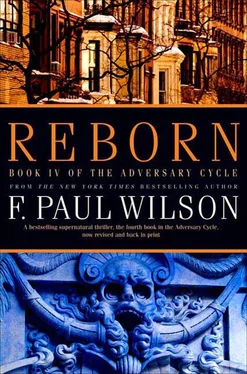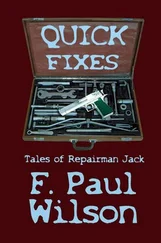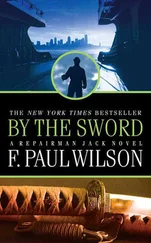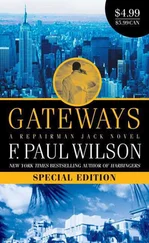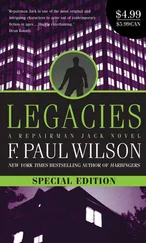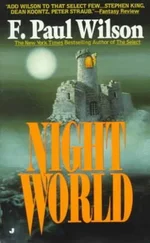F. Paul Wilson - Reborn
Здесь есть возможность читать онлайн «F. Paul Wilson - Reborn» весь текст электронной книги совершенно бесплатно (целиком полную версию без сокращений). В некоторых случаях можно слушать аудио, скачать через торрент в формате fb2 и присутствует краткое содержание. Жанр: Ужасы и Мистика, на английском языке. Описание произведения, (предисловие) а так же отзывы посетителей доступны на портале библиотеки ЛибКат.
- Название:Reborn
- Автор:
- Жанр:
- Год:неизвестен
- ISBN:нет данных
- Рейтинг книги:5 / 5. Голосов: 1
-
Избранное:Добавить в избранное
- Отзывы:
-
Ваша оценка:
- 100
- 1
- 2
- 3
- 4
- 5
Reborn: краткое содержание, описание и аннотация
Предлагаем к чтению аннотацию, описание, краткое содержание или предисловие (зависит от того, что написал сам автор книги «Reborn»). Если вы не нашли необходимую информацию о книге — напишите в комментариях, мы постараемся отыскать её.
Reborn — читать онлайн бесплатно полную книгу (весь текст) целиком
Ниже представлен текст книги, разбитый по страницам. Система сохранения места последней прочитанной страницы, позволяет с удобством читать онлайн бесплатно книгу «Reborn», без необходимости каждый раз заново искать на чём Вы остановились. Поставьте закладку, и сможете в любой момент перейти на страницу, на которой закончили чтение.
Интервал:
Закладка:
Little did I know that Albert Einstein was simultaneously writing a similar letter to Roosevelt regarding the development of an atom bomb.
As I said above, it all would have come to naught if Hitler had behaved. But his attack on Poland in September of that year spurred Roosevelt into initiating two secret research projects. The atomic project was code—named "Manhattan" and given over to Oppenheimer, Fermi, Teller, and Bohr. The eugenics project was assigned to yours truly and a very bright young M.D. named Edward Derr. Our project was called "Genesis."
I did not receive much in the way of funding, but that didn't matter. When the government appropriations fell short, I supplemented them with my own funds. I wasn't in this for the money. I had more than I could spend. I was in it for the doing!
It is so very important to me that you understand that part of my persona, Jim. This was new ground, virgin territory, terra incognita, like Roald Amundsen leaving the first human footprints in the snow at the South Pole. I wanted to be first. Some might call it the pioneer spirit, some might call it monomania. Call it what you will, I wanted to do what no man had done before .
Once I get started on a project, there is no stopping me. The Genesis Project was no exception. I even infected Derr with my mania. We worked like automatons, sometimes going days without sleep, weeks without stopping. The government wasn't pushing us. Pearl Harbor was still two years away. There was no time limit. We created our own pressure.
You see, in a way, we were trying to reinvent the wheel. Early on we looked at natural selection, which is the way Nature came up with the fittest species for an ecological niche, and tried to transpose that onto a fighting man. We quickly developed theories and possible solutions to the problem of breeding the supersoldier, all of which would take generations to prove.
So we discarded them.
I was dissatisfied with the very idea of breeding, anyway. At root no doubt in that dissatisfaction was my impatient nature. I wanted results now, not generations hence. But even more so, the capriciousness of genetic mixing seemed an unscalable barrier .
Let me give you a few basics.
Each human cell is diploid, which means it has 46 chromosomes. The combination and arrangement of genes on these chromosomes makes up the genotype, which in turn determines the phenotype, the physical expression of those genes; that is, the bodily characteristics of each individual person: sex, skin color, body type, even personality to some extent. If the presence of one gene was all that was required to make a supersoldier, there would be no problem — eugenics would give us a high success rate .
Unfortunately that is not the case. A supersoldier phenotype can only result from a highly specific and extraordinarily complex genotype, providing such characteristics as a large-framed skeleton, strong musculature, agile limbs, quick reflexes, high threshold of pain, an obedient, aggressive personality, and so on.
Here's where the whole breeding approach falls apart. You see, we mammals reproduce by joining a female gamete (an ovum) with a male gamete (a spermatozoon). Each gamete is haploid, meaning it has only 23 chromosomes (half the normal complement). When they join together, they form a brand-new 46-chromosome (diploid) person. The stumbling block for us would-be breeders is that when a diploid cell breaks up into two haploid gametes, we have no way of controlling which genes go into which gamete. The process is random. So anything is possible. This is a wonderful means of providing the human race with nearly endless variety within the parameters of our species, thereby allowing us to adapt to various environments and situations. But it is pure hell to someone trying to produce the same genotype and phenotype over and over.
So to give you an example, let's take Attila the Hun and mate him with Joan of Arc. We could get a strong, brave, ferocious, idealistic supersoldier. Or we could get a 98-pound anemic accountant. Attila and Joan, no matter how strong and brave and aggressive they each may be, have recessive anemic accountant genes hiding on their chromosomes. If we take from each a haploid gamete rich in recessive anemic accountant genes and pair them, we will get an anemic accountant. The pairing of any two random gametes from each could result in anything between the two extremes. The odds can be skewed in your favor by rigorous investigations of the family trees, but it's still a crapshoot. And since humans don't breed like mice or rabbits, it would take lots of luck and many generations to breed a supersoldier army .
What was needed was a way to move a desirable genotype intact (the word intact cannot be overemphasized here) from generation to generation. In other words, we had to find a way of creating identical twins (or triplets or quints, or what have you) a generation removed from the original .
We needed to produce a series of beings genetically identical to their parent. (Note the singular, please.)
Clones, if you will .
We had to learn how to clone a human being.
Now, when you remove yourself from the fray and sit back and consider it without emotion, that is a pretty frightening concept. But Derr and I were in the thick of the fray. We were filled with the passion and fervor of discovery. Nothing frightened us. Questions of ethics or responsibility were far from our minds.
The only question that mattered was : How?
A tissue culture was out. A human body is a complex system of many different tissues. We could not culture out individual organs and patch them together like a modern Frankenstein. What we needed was a way to induce a human ovary to form an egg with a nucleus that was diploid instead of haploid. The result would be cloning by parthenogenesis, and only females would result, but it would be a start.
Then a chance remark by Derr set us on the right track. He said, "Too bad we can't just get hold of some ova and plop the genotype we want into them ."
It was one of those rare moments of shared epiphany. You look at each other with wide eyes, then leap up and jump around and begin shouting ideas back and forth like a couple of madmen. That was Derr and I.
Looking back now, I think that perhaps we truly were mad.
But it was a glorious madness. I can't describe the excitement we felt. And even now I wouldn't trade those times for anything. We shared a feeling of masterfulness. I'm not sure there is such a word, but if it doesn't exist, it should. We felt that we were on the verge of something epochal, that just beyond our questing fingertips lay the secret of mastering Creation .
And it was just the two of us. That was the most enthralling part of it. Only Derr and I had the Big Picture. We had technicians for the scut work, of course, but the duties of each were narrowly circumscribed. My three-floor town house was partially converted into two labs. Some worked in the third-floor lab, others worked in the basement lab. Only we knew where the sum of all the scut work was headed. The whole would truly be greater than the sum of its parts.
We started small. We looked for an aquatic, oviparous reptile with good-size eggs. We settled for an amphibian. That was Derr's idea. He had trained in Europe where frogs are frequently used for research. We obtained a supply of green frogs and some special pure-white albino frogs. We were ready to begin.
After much trial and error we perfected a microscopic technique of removing the haploid nucleus from the egg of a green frog and replacing it with a diploid nucleus removed from a body cell of a white frog. All the genetic information from the albino frog now resided in the egg cell from the green. The egg cell, in a sense, had been fertilized. After many failures and botch-ups, we eventually got it right. Soon we were awash in white tadpoles.
Читать дальшеИнтервал:
Закладка:
Похожие книги на «Reborn»
Представляем Вашему вниманию похожие книги на «Reborn» списком для выбора. Мы отобрали схожую по названию и смыслу литературу в надежде предоставить читателям больше вариантов отыскать новые, интересные, ещё непрочитанные произведения.
Обсуждение, отзывы о книге «Reborn» и просто собственные мнения читателей. Оставьте ваши комментарии, напишите, что Вы думаете о произведении, его смысле или главных героях. Укажите что конкретно понравилось, а что нет, и почему Вы так считаете.
